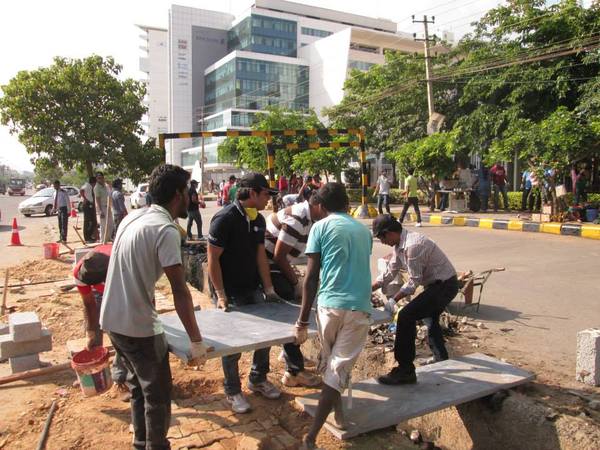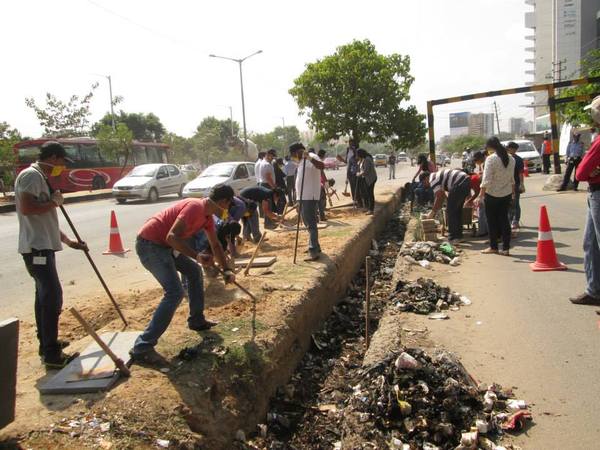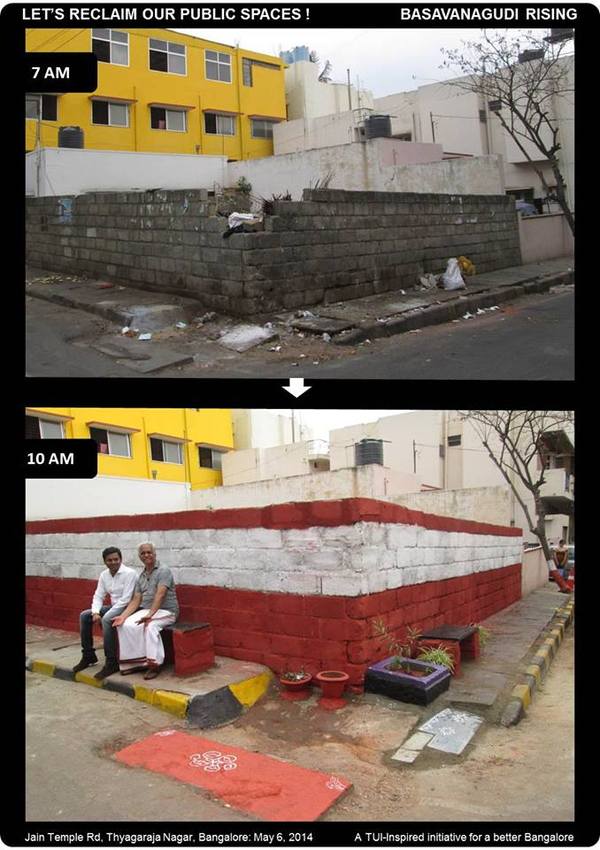What do you do when you see a garbage dump near your home or slabs misplaced from the footpath drains, and don’t see any civic agency going anything to solve the problem?
Just go out and do it yourself! This is the motto behind a Bangalorean movement called The Ugly Indian.

Citizens inspired by The Ugly Indian movement working to fix a drain. Pic: The Ugly Indian
The Ugly Indian is an apolitical, anonymous group of citizens who feel strongly about the visible filth in Indian cities. The movement, aimed at solving problems at public spaces with direct action and a common-sense problem-solving approach, started in Bengaluru.
In 2010, a small team of citizens who were frequent visitors of Church Street near MG Road, worked with all the stakeholders—the commercial establishments in the area, BBMP systems for clearing garbage etc. —and transformed an ugly garbage dump corner. This was the first widely publicised ‘Spot fix. ’ Then the team moved on give a makeover to entire Church Street and MG Road area. Now it is spread across Bengaluru and spreading to other parts of India.
How do I get involved in a cleanup?
If you want to join a spotfix, mail theuglyindian@gmail.com and sign up as a volunteer. You will be invited to a fix in your neighbourhood. The Ugly Indian Spotfixes are invitation-only community events that typically happen every weekend from 7 am – 10 am.
Why the name, The Ugly Indian?
An Ugly Indian is the average Indian who doesn’t think much before uglying a public space—when he sees an ugly corner, he contributes to ugliness by littering or peeing in public, thereby making the space unusable and prone to more such attacks.
Given a chance, this Ugly Indian would want to contribute to keeping our public spaces clean—nobody litters a clean public space, so give him a chance to come clean by keeping the surroundings clean—is what The Ugly Indian movement believes in. Hence the name The Ugly Indian (TUI).
TUI believes that many of the problems are hard to solve even if the government and public work closely together and money was freely available. The Ugly Indian does not finger-point or blame the system. The aim is to make a change from within – one that sustains because everyone wants it and is comfortable with it.
The movement follows the simple philosophy: Stop Talking, Start Doing. Baayi Muchko, Kelasa Hachko. Kaam Chalu, Muh Bandh.

Do not point fingers – go out and just do it. Pic: The Ugly Indian
What are TUI guidelines?
-
No lectures, no moralising, no activism, no self-righteous anger.
-
No confrontation, no arguments, no debates, no pamphlets, no advocacy.
-
Don’t step on anyone’s toes, don’t take sides in any ideological debates
-
Support existing systems and improve their effectiveness for the greater good.
-
Get real. Treat everyone with sincerity, respect and dignity first, and the greater good will be an outcome.
TUI also believes that:
-
The names and identities of specific individuals are not important. What matters is visible results.
-
Any visible result in the public space needs the support of hundreds of actors (the ‘community’).
-
One Ugly Indian in each community can, and must, take the first step—but unless the community responds positively, that step will not produce results.
Why a spotfix, when to do it?
The Ugly Indian has defined ugliness in public spaces and streets with seven parameters:
-
nPOP – No Posters on Public Properties
-
nGOG – No Garbage on Ground
-
nPIP – No Peeing in Public
-
nFIF = No Fault in Footpath
-
nTOT = No Trash on Trees
-
nWOW = No Writing on Wall
-
nDOD = No Dumping of Debris
When you see any of the above, which is not addressed by civic agencies/the failure to fix the root cause of the problem, it is time to undertake a spotfix. The spotfix is required in the areas where multiple efforts by multiple agencies cannot change the human behaviour of contributing to ugliness.

A spot-fix done by The Ugly Indians in collaboration with BBMP in Basavanagudi. Pic courtesy: The Ugly Indian
How do I initiate a spot fix in my neighbourhood?
There is no set references for how to spot-fix. Just go out and do it. You have to plunge in, make mistakes and learn. You will be using the skills you have – as simple as cleaning your own compound, your own toilets, unclogging your own kitchen sink, removing cobwebs from the roof, painting your own walls, etc.
Go out and sweep a corner, or remove posters that you see on walls, or water a tree. If you want to do more, join the Ugly Indian team in your neighbourhood. They are armed with toolkits and expertise to undertake any spot-fixing, and are capable of guiding you.
Can The Ugly Indian do the clean up in my place?
No. The Ugly Indian is not a city-cleaner group. The Ugly Indian is you, and everybody else around you. It is a problem-solving movement. If you are ready to dirty your hands, putting in your effort and small amount of money into it, you can make the change happen. Otherwise, no, somebody else doesn’t come and do it for you. Even if they do, it will not sustain, as those who dirty the place will not know the pain and joy of cleaning it up and giving it a makeover.
How does it get funded, whose fix is it finally ?
It is funded by the volunteers who take part in it. Those who put in their time and money don’t boast about it, they just do the required and move on to the next fix!
There are thousands of volunteers enrolled in Bengaluru alone. for them, it is a weekend hobby that brings joy and satisfaction, while for others it is a way of giving the goodwill back to the society.
What is a successful spotfix?
The Ugly Indian defines a ‘solution’ as a real solution if it –
- Sustains in the public street for at least 90 days.
- With no supervision.
- Is low-cost (ideally free) and easy to implement and replicate
- Changes the behaviour and attitudes of all concerned
- Creates minimal change in the daily actions of everyone concerned (nobody should lose a job, lose a source of income, or get seriously inconvenienced)
How many Bengaluru fixes have happened ?
The Ugly Indian spot fixes in Bengaluru are above 400, out of which around 380 have survived, according to the statistics available with TUI.
What are some smart solutions evolved by TUI?
Terebins (smart bins meant for public spaces widely used in MG Road), WonderLoos (low cost, low maintenance loos used in Church Street), TUI Pillar-Wrap (used to paint concrete pillars from paan stains and dustbins in Trinity circle) are some of them.
How do I join the movement?
If you want to join a spotfix, mail theuglyindian@gmail.com and sign up as a volunteer. You will be invited to a fix in your neighbourhood. The Ugly Indian Spotfixes are invitation-only community events that typically happen every weekend from 7:00 am – 10:00 am.
There are a dozen local groups, called ‘Rising’ initiatives – which enable people in particular areas to team up and decide on local spot fixes and follow ups. This helps volunteers in avoiding travel from one part of Bengaluru to another to participate in a spotfix, and helps them connect with people in their own areas. Each Rising initiative has a Facebook page.
Facebook page:https://www.facebook.com/theugl.yindian
Twitter: https://twitter.com/theuglyindian
Website: theuglyindian.com
Email: theuglyindian@gmail.com
Read the story: theuglyindian.com/books
Note: The information has been compiled based on the information available on the TUI website and Facebook pages. TUI is a secretive, anonymous citizen group that does not want to be in limelight.
Related Articles